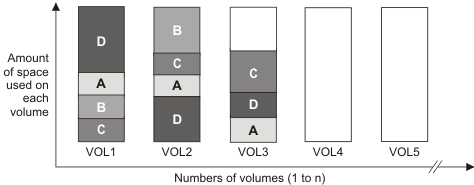When collocation is disabled, the server attempts to use all available space in a storage volume before it accesses another volume.
When storing client files in a sequential-access storage pool where collocation is disabled, the server selects a volume using the following selection order:
- A previously used sequential volume with available space (a volume with the most amount of data is selected first)
- An empty volume
When the server needs to continue to store data on a second volume, it attempts to select an empty volume. If none exists, the server attempts to select any remaining available volume in the storage pool.
Figure 1 shows that volume utilization is vertical when collocation is disabled. In this example, fewer volumes are used because the server attempts to use all available space by mixing client files on individual volumes. A, B, C, and D represent files from four different client nodes.
